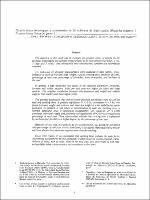| dc.description.abstract | The objective of this work was to estimate the possible effect of variety on the physical, organoleptic and culinary characteristics of 20 bean varieties (10 black, 4 red, 3 beige and 3 white) and, taking yield into consideration, correlate the information obtained.
The following 10 physical characteristics were measured in each variety color, brilliance or shine of the seed coat, weight, volume, cooking time, thickness of broth, percentage of seed coat, percentage of cotyledon, water absorption, and hardness of the seed.
In general, a high variability was found in the different parameters measured, between and within varieties. Yield per unit area was higher for black and beige varieties The negative correlation between this parameter and weight and volume suggests that smaller seeds have higher yields.
The physical parameters that showed better practical possibilities were size of the seed and cooking time A positive significant (P < 0.01) correlation (r = 0.96) was found between weight and volume, and since dry weight is a less variable and easier parameter to measure, it was taken as representative of seed size. Cooking time, a relevant parameter since it determines acceptability, was negatively (P < 0.05) correlated with seed weight, and positively and significantly (P < 0.01 ) correlated with percentage of seal coat. These relationships Indicate that cooking time is influenced by seed size and, possibly to a higher degree, by the percentage of seed coat. Hardness of the seed, as measured by the penetrometer, was positively correlated with percentage of seed coat; on the other hand, it was found that a seed with a shinier seed coat absorbs less water and requires more time for cooking. From these results, it was concluded that cooking time, perhaps the main factor determining acceptability by the consumer, is determined by several physical characteristics of beans, such as color, shine of the seed coat, size, percentage of seed coat, and probably other characteristics not considered in this work. | es_ES |


